Classic Uzbekistan Tour Package
8 Days Private Tour of Tashkent - Samarkand - Bukhara - Kyzylkum Desert - Khiva - Urgench - Tashkent
Tour Type: Private guided tour, flexible and customizable
Transportation: Comfortable air-conditioned private car with driver
Accommodation: 3 to 4-star hotels, open to your own choice
Meals: 7 breakfasts
Code: TUZ01
Transportation: Comfortable air-conditioned private car with driver
Accommodation: 3 to 4-star hotels, open to your own choice
Meals: 7 breakfasts
Code: TUZ01
This trip can be customized to meet your individual needs!
From USD1499USD1349Free Inquiry
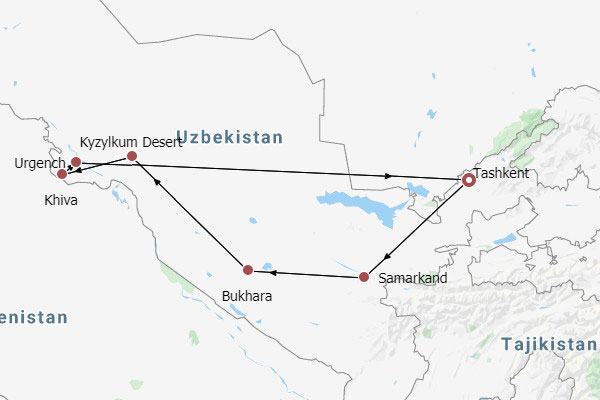
- Itinerary
- Prices
- Reviews
Trip Highlights
- Witness the centuries-old paper-making techniques at Koni Ghil Village in Samarkand.
- Glimpse Uzbekistan’s vibrant handicrafts and artworks at the State Museum of Applied Art in Tashkent.
- Wander through the labyrinthine alleys to experience slow-paced local life in Bukhara.
- Explore the UNESCO-listed inner fortified city in Khiva, Ichan Kala, full of minarets, mosques, and madrasahs.
- Traverse the vast Kyzylkum Desert to encounter wild camels and see various rock formations.
Expand All
Collapse All
Day 1 Tashkent Airport Pick-up; Visit Khast-Imam Complex, Chorsu Bazaar, State Museum of Applied Art
Welcome to the first destination of your Uzbekistan tour packages, Tashkent! Upon arrival, our driver will offer you an airport pick-up and send you to the hotel downtown. After settling down, our private guide will accompany you to explore the capital city.
As one of only two doubly landlocked countries in the world, Uzbekistan is located at the crossroads of Central Asia and Central Europe. Its capital, Tashkent, once served as a vital Silk Road nexus, making it a coveted place of many conquerors, such as Genghis Khan and Timur, who have bequeathed a legacy of dazzling culture and architecture.
The first stop, the Khast-Imam Complex, is the best demonstration, where the main buildings, including the Barakh-khan Madrasah, Tilla Sheikh Mosque, and Mausoleum of Saint Abu Bakr Kaffal Shashi, showcase quintessential Central Asian design. Their minarets stand like sentinels flanking grand portals decorated with intricate tilework. Looking up at their entrance, you’ll be dazzled by stalactite-like vaults. The Islamic Institute of Imam al-Bukhari on the northwest corner of the square, which is still in use today, is one of the paramount meccas for all Uzbek Muslims.
Then, head to Tashkent’s biggest bazaar, Chorsu Bazaar, characterized by its outstanding blue dome. Stepping inside, you’ll feel like you are in a vibrant hive where the vendors’ hawking, bargaining chatter, and rattling carts create a symphony of Uzbek daily life. The ground floor brims with fresh produce and meats, while the upper tier is a fragrant world of spices and dried fruits. Besides, its open-air sections offer traditional crafts such as carpets and wooden carvings. Craving street food? Just follow your nose! The irresistible aromas of kebabs and flatbread will guide you to the sizzling grills.
► Payment Tip: Only Uzbekistani som (UZS) cash is accepted in the market. Exchange currency beforehand at street ATMs. Most machines accept Visa, Maestro cards, or US dollars, while some may also take Mastercard.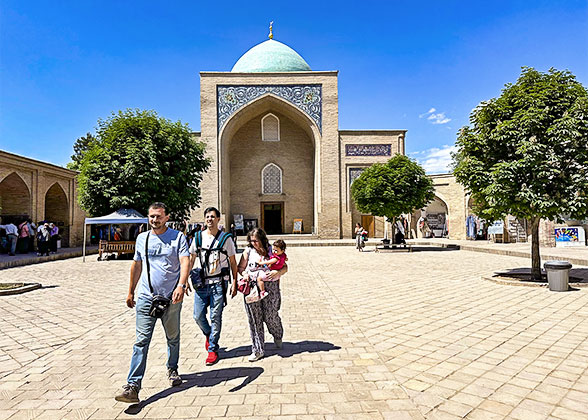
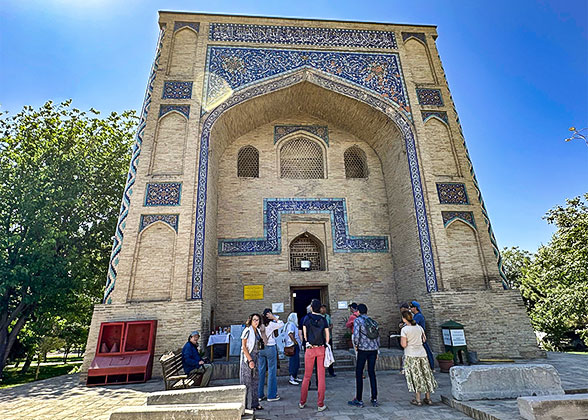 Afterwards, have a glimpse of traditional Uzbek artifacts from the 19th century onward at the State Museum of Applied Art. Among over 7,000 exhibits, you can see folk art pieces, such as exquisite ceramics, handwoven and embroidered textiles, intricate carpets, and traditional musical instruments. In addition, the museum’s decoration is also worth appreciating: its interior and exterior surfaces are adorned with mesmerizing carved plaster and painted designs featuring elaborate floral and geometric patterns.
Afterwards, have a glimpse of traditional Uzbek artifacts from the 19th century onward at the State Museum of Applied Art. Among over 7,000 exhibits, you can see folk art pieces, such as exquisite ceramics, handwoven and embroidered textiles, intricate carpets, and traditional musical instruments. In addition, the museum’s decoration is also worth appreciating: its interior and exterior surfaces are adorned with mesmerizing carved plaster and painted designs featuring elaborate floral and geometric patterns.
Leaving the museum, the guide will accompany you to descend underground to have a peek at the Soviet remnant - the Tashkent subway, which Uzbeks are proud of not just as a transportation system but as art. For example, the Alisher Navoiy Station, named after the 15th-century Uzbek poet, embodies Timurid architectural grandeur. Overhead, the cavernous vaults adorned with intricate floral patterns are illuminated by white lights. On the walls, the ceramic murals depict scenes from Navoiy’s epic poems. Get off and meet the driver in the city center. Then we will continue to the Independence Square and the nearby Amir Timur Park, and your Tashkent sightseeing will conclude at the Earthquake Memorial.
 Uzbekistan Information:
Uzbekistan Information:
1. Visa Requirements: Citizens of the EU and the other 66 countries, including the UK and New Zealand, can enjoy a visa-free policy. Travelers from 50 countries, including the United States, require an e-visa, which is typically processed within 1-2 weeks. But US citizens under 16 and over 55 are exempt from the visa requirement as well.
2. Mobile Networks: Uztelecom is the most reliable operator with a wider signal coverage, especially in rural areas where others may struggle. An 8-day trip typically requires around 10 GB of data, costing approximately USD 10. SIM cards can be purchased at local shops or official provider offices.
Accommodation: Wyndham Tashkent (4 stars) or similar
As one of only two doubly landlocked countries in the world, Uzbekistan is located at the crossroads of Central Asia and Central Europe. Its capital, Tashkent, once served as a vital Silk Road nexus, making it a coveted place of many conquerors, such as Genghis Khan and Timur, who have bequeathed a legacy of dazzling culture and architecture.
The first stop, the Khast-Imam Complex, is the best demonstration, where the main buildings, including the Barakh-khan Madrasah, Tilla Sheikh Mosque, and Mausoleum of Saint Abu Bakr Kaffal Shashi, showcase quintessential Central Asian design. Their minarets stand like sentinels flanking grand portals decorated with intricate tilework. Looking up at their entrance, you’ll be dazzled by stalactite-like vaults. The Islamic Institute of Imam al-Bukhari on the northwest corner of the square, which is still in use today, is one of the paramount meccas for all Uzbek Muslims.
Then, head to Tashkent’s biggest bazaar, Chorsu Bazaar, characterized by its outstanding blue dome. Stepping inside, you’ll feel like you are in a vibrant hive where the vendors’ hawking, bargaining chatter, and rattling carts create a symphony of Uzbek daily life. The ground floor brims with fresh produce and meats, while the upper tier is a fragrant world of spices and dried fruits. Besides, its open-air sections offer traditional crafts such as carpets and wooden carvings. Craving street food? Just follow your nose! The irresistible aromas of kebabs and flatbread will guide you to the sizzling grills.
► Payment Tip: Only Uzbekistani som (UZS) cash is accepted in the market. Exchange currency beforehand at street ATMs. Most machines accept Visa, Maestro cards, or US dollars, while some may also take Mastercard.

Khast-Imam Complex, Tashkent

Khast-Imam Complex
Leaving the museum, the guide will accompany you to descend underground to have a peek at the Soviet remnant - the Tashkent subway, which Uzbeks are proud of not just as a transportation system but as art. For example, the Alisher Navoiy Station, named after the 15th-century Uzbek poet, embodies Timurid architectural grandeur. Overhead, the cavernous vaults adorned with intricate floral patterns are illuminated by white lights. On the walls, the ceramic murals depict scenes from Navoiy’s epic poems. Get off and meet the driver in the city center. Then we will continue to the Independence Square and the nearby Amir Timur Park, and your Tashkent sightseeing will conclude at the Earthquake Memorial.
1. Visa Requirements: Citizens of the EU and the other 66 countries, including the UK and New Zealand, can enjoy a visa-free policy. Travelers from 50 countries, including the United States, require an e-visa, which is typically processed within 1-2 weeks. But US citizens under 16 and over 55 are exempt from the visa requirement as well.
2. Mobile Networks: Uztelecom is the most reliable operator with a wider signal coverage, especially in rural areas where others may struggle. An 8-day trip typically requires around 10 GB of data, costing approximately USD 10. SIM cards can be purchased at local shops or official provider offices.
Accommodation: Wyndham Tashkent (4 stars) or similar
Day 2 High-speed Train to Samarkand: Registan Square, Ulugbek Observatory, Gur-Emir Mausoleum
After breakfast, our driver will transfer you to catch the 2-hour high-speed train to Samarkand. As a city successively conquered by Alexander the Great in 329 BC and Genghis Khan in the 13th century, Samarkand experienced its rebirth in the 14th century after Timur established it as the capital of his empire in Transoxiana, a region that roughly corresponds to parts of present-day Uzbekistan, Tajikistan, Kazakhstan, Turkmenistan, and Kyrgyzstan. Now, it remains a shining 'blue jewel' in Central Asia, with over 600 Islamic madrasahs, mosques, and minarets.
Upon arrival, the Samarkand driver will pick you up and escort you to the hotel for check-in. After, our guide will accompany you to embark on a Samarkand highlights tour. First, head to the Registan Square dominating the city center, where the two-tiered Ulugh Beg Madrasah offers stunning cobalt-blue domes and portals adorned with ceramic star-shaped patterns symbolizing the cosmos and astronomy.
► For Your Information: At 7 PM, lights will illuminate the square. If lucky, you may even have a chance to see a 30-minute 3D light show tailored by the rich. If there is not, do not feel disappointed, because there will be a common light show at 8 or 9 PM, where lasers dance across millennia-old facades to modern rhythms.
Then, wander through the bustling Siyob Bazaar, and have a glimpse of the grandiose Bibi Khanym Mosque, boasting its 41-meter-high (135-foot) rebuilt azure cupola, which resembles an inverted sapphire bowl. If you happen to visit here during the prayer times, you may see locals kneeling and prostrating. Continue driving to the Ulugbek Observatory to see the most advanced astronomical instruments of the 15th century, including the remnant of a huge angle-measuring instrument buried underground. Astonishingly, the Samarkand astronomers listed the positions of 1,018 stars merely through naked-eye observation.
Nearby, Shah-i-Zinda Necropolis, the tombs of royal females during the Timurid era, stretches on the slope of the hill. Following its avenue, you’ll be wowed by the dazzling miniature-decorated portals. Inside, intricate tilework on the vault and the walls makes you feel as if you are in a world of a kaleidoscope. Finally, let’s pay homage to Timur, the founder of the Timurid Empire (1370-1507) at the Gur-Emir Mausoleum. Allegedly, the mausoleum was originally built for Timur’s grandson, but finally became the resting place of Timur himself, because the snowstorm blocked the way to his planned grave in Shahrisabz after he died in 1405. The mausoleum is splendid with turquoise domes and glazed lapis lazuli walls, so wearing vibrant clothes such as emerald and crimson is more photogenic.
 Restaurant Recommendation (at your own expense)
Restaurant Recommendation (at your own expense)
As Samarkand’s most iconic eatery, Samarkand Restaurant dazzles customers with its regal decoration yet offers wallet-friendly local cuisine. If someone orders a whole-roasted lamb, the staff will perform a traditional song and dance to celebrate. The first floor is generally boisterous, so if you seek a quieter dining experience, request the upper floor or private booths. Plov, kebabs, and samsa (a kind of Uzbek baked pastry) are must-tries, and a napoleon, a Soviet-era dessert, is recommended.
Average Cost per Person: UZS 160,000 (USD 20)
Address: Makhmuda Koshgari, 54, Samarkand, Uzbekistan
Meals: Breakfast
Accommodation: Grand Samarkand Superior (4 stars) or similar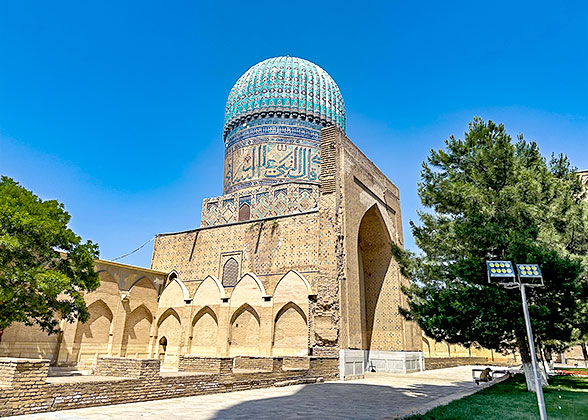
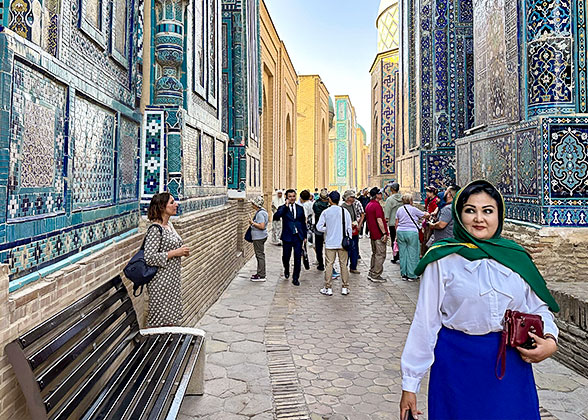
Upon arrival, the Samarkand driver will pick you up and escort you to the hotel for check-in. After, our guide will accompany you to embark on a Samarkand highlights tour. First, head to the Registan Square dominating the city center, where the two-tiered Ulugh Beg Madrasah offers stunning cobalt-blue domes and portals adorned with ceramic star-shaped patterns symbolizing the cosmos and astronomy.
► For Your Information: At 7 PM, lights will illuminate the square. If lucky, you may even have a chance to see a 30-minute 3D light show tailored by the rich. If there is not, do not feel disappointed, because there will be a common light show at 8 or 9 PM, where lasers dance across millennia-old facades to modern rhythms.
Then, wander through the bustling Siyob Bazaar, and have a glimpse of the grandiose Bibi Khanym Mosque, boasting its 41-meter-high (135-foot) rebuilt azure cupola, which resembles an inverted sapphire bowl. If you happen to visit here during the prayer times, you may see locals kneeling and prostrating. Continue driving to the Ulugbek Observatory to see the most advanced astronomical instruments of the 15th century, including the remnant of a huge angle-measuring instrument buried underground. Astonishingly, the Samarkand astronomers listed the positions of 1,018 stars merely through naked-eye observation.
Nearby, Shah-i-Zinda Necropolis, the tombs of royal females during the Timurid era, stretches on the slope of the hill. Following its avenue, you’ll be wowed by the dazzling miniature-decorated portals. Inside, intricate tilework on the vault and the walls makes you feel as if you are in a world of a kaleidoscope. Finally, let’s pay homage to Timur, the founder of the Timurid Empire (1370-1507) at the Gur-Emir Mausoleum. Allegedly, the mausoleum was originally built for Timur’s grandson, but finally became the resting place of Timur himself, because the snowstorm blocked the way to his planned grave in Shahrisabz after he died in 1405. The mausoleum is splendid with turquoise domes and glazed lapis lazuli walls, so wearing vibrant clothes such as emerald and crimson is more photogenic.
As Samarkand’s most iconic eatery, Samarkand Restaurant dazzles customers with its regal decoration yet offers wallet-friendly local cuisine. If someone orders a whole-roasted lamb, the staff will perform a traditional song and dance to celebrate. The first floor is generally boisterous, so if you seek a quieter dining experience, request the upper floor or private booths. Plov, kebabs, and samsa (a kind of Uzbek baked pastry) are must-tries, and a napoleon, a Soviet-era dessert, is recommended.
Average Cost per Person: UZS 160,000 (USD 20)
Address: Makhmuda Koshgari, 54, Samarkand, Uzbekistan
Meals: Breakfast
Accommodation: Grand Samarkand Superior (4 stars) or similar

Bibi Khanym Mosque, Samarkand

Shah-i-Zinda Necropolis
Day 3 Samarkand: Afrasiab Museum, Tomb of Saint Daniel, Watch Traditional Paper-Making
In the morning, our guide will pick you up from the hotel to go to the Afrasiab Museum, one of the most important museums in Samarkand. Perched atop the ruins of ancient Adresiab - a thriving Sogdian city from the 7th to 13th century, it preserves more than 22,000 items, which vividly resurrect the story of the Silk Road’s most influential traders. The crown jewels are the murals from the 7th to 8th centuries in the Ambassadors' Hall. The west wall depicts the scene of a Sogdian king receiving envoys from other countries; the fragments of the east wall reveal the vibrant celebration scenario of an Indian festival, while the north wall shows hunting and boat scenes of the Chinese Emperor and Empress during the Tang dynasty (618-907). Beyond murals, you can trace Sogdian history by watching their coins, weaponry, and pottery.
To the north of the museum is the Tomb of Saint Daniel, the resting place of the Islamic prophet. What attracts various pilgrims is not only its spiritual importance, but also its spring, which is said to be able to cure diseases. Besides, it is miraculous that the saint’s corpse keeps growing, and now reaches 18 meters (59 feet) long.
We will then leave you free time to explore the surroundings. You can wander along the stream, hear the creak of waterwheels, or just relax in the teahouse, and immerse yourself in the mellow breeze. In the end, the guide will escort you back to the hotel in the city center.
 Suggestions for Free Time in Samarkand:
Suggestions for Free Time in Samarkand:
If you are still energetic and want to explore more about Samarkand on your own, head to the Eternal City. This newly built pedestrian recreates Uzbekistan’s architectural icons from Tashkent, Bukhara, Khiva, and so on. In addition, there are many souvenir stores, overflowing with exquisite but overpriced handicrafts. When the night comes, the pedestrian will be illuminated by blue and golden lights, and sometimes there are firework shows or street folk performances.
► Car-hailing Tip: Yandex Go is convenient, which allows you to link a Visa card for payment. Though the app will display the estimated fare, it is recommended to negotiate with the driver in advance. It generally costs UZS 20,000-25,000 (USD 1.5-2) to get here from the city center.
Meals: Breakfast
Accommodation: Grand Samarkand Superior (4 stars) or similar
To the north of the museum is the Tomb of Saint Daniel, the resting place of the Islamic prophet. What attracts various pilgrims is not only its spiritual importance, but also its spring, which is said to be able to cure diseases. Besides, it is miraculous that the saint’s corpse keeps growing, and now reaches 18 meters (59 feet) long.
★ Explore the Paper-making Process in Koni Ghil Village
After the Battle of Talas between ancient China and the Arab Empire in 751, the captured Chinese artisans introduced the paper-making techniques to Samarkand and transformed the city into a paper-making hub. Nevertheless, after the Industrial Revolution, the craft was gradually forgotten. Thanks to the Meros Paper Mill in the Koni Ghil Village, we can witness the surviving 1,270-year-old technique. Here, you can watch the branches of mulberries be stripped and boiled into pulp, then sieved on screens and pressed into sheets, and finally polished with horns or shells to be smooth. Due to the duration of the Samarkand paper, it is favored by artists and calligraphers. You’ll also find the paper-making wedding gowns, masks, and dolls in the factory.We will then leave you free time to explore the surroundings. You can wander along the stream, hear the creak of waterwheels, or just relax in the teahouse, and immerse yourself in the mellow breeze. In the end, the guide will escort you back to the hotel in the city center.
If you are still energetic and want to explore more about Samarkand on your own, head to the Eternal City. This newly built pedestrian recreates Uzbekistan’s architectural icons from Tashkent, Bukhara, Khiva, and so on. In addition, there are many souvenir stores, overflowing with exquisite but overpriced handicrafts. When the night comes, the pedestrian will be illuminated by blue and golden lights, and sometimes there are firework shows or street folk performances.
► Car-hailing Tip: Yandex Go is convenient, which allows you to link a Visa card for payment. Though the app will display the estimated fare, it is recommended to negotiate with the driver in advance. It generally costs UZS 20,000-25,000 (USD 1.5-2) to get here from the city center.
Meals: Breakfast
Accommodation: Grand Samarkand Superior (4 stars) or similar
Day 4 High-speed Train to Bukhara: Miri-Arab Madrasah, Trade Domes Market, Chor-Minor Madrasah
After breakfast, you’ll be escorted to the train station, and a 2-hour morning high-speed train will transfer you to Uzbekistan’s third-largest city, Bukhara. This is a must-visit destination for fans of One Thousand and One Nights, where the grand portals and towering minarets create an immersive medieval tableau. Unlike majestic Samarkand, Bukhara whispers its stories through labyrinthine alleys. Here, you can experience its heritage while immersing yourself in its slow-paced daily life as a temporary local rather than a visitor.
Upon arrival, the local driver will transfer you to the hotel, and then our guide will accompany you to enjoy a Bukhara walking tour. First, head to the 47-meter-high (154-foot) Kalyan Minaret built in the 12th century. Regarded as the lighthouse of the desert, it shimmers under the sun, with intricate geometric brickwork and a honeycomb-like top. After having a peek at the Kalyan Mosque behind the minaret and the adjacent Islamic school, Miri-Arab Madrasah, visit the brick artwork Magoki-Attori Mosque, which was once a shrine of Zoroastrianism in the 5th century, and now houses a museum displaying various exquisite hand-embroidered carpets and prayer cushions.
Then, continue to one of Central Asia’s oldest Islamic institutions, Ulugh Beg Madrasah, and Abdulaziz Khan Madrasah featuring honeycomb-like vaults. Afterward, lose yourself in the four surviving 16th-century bustling Trade Domes Market, whose domes provide an ideal place to escape the summer heat. Vendors’ hawking echoes across vaulted galleries where you’ll find wooden carvings, embroidered suzani textiles, and iconic Uzbek telpak hats.
Following the corridors of the market, let’s get to the Lyabi Hauz Ensemble, the heart of Bukhara. Surrounding its central pond, there are two old Islamic schools, a Sufi shrine, and various restaurants, cafes, and souvenir stores, which is a good place to feel the blend of the past and the contemporary life of Bukhara. Finally, today’s walking tour will end at the Chor-Minor Madrasah. Defying conventional Islamic architecture, this 17-meter-high (56-foot) building resembles a reversed stool. If you ascend its central dome, you can see distinct religious symbolism on the four turquoise domes: Christian crosses, Buddhist prayer wheels, Islamic crescent moons, and Zoroastrian solar disks.
 Planning Tip: Bukhara is at its Liveliest during the Silk & Spice Festival
Planning Tip: Bukhara is at its Liveliest during the Silk & Spice Festival
Bukhara honors its Silk Road legacy with this vibrant event biennially in late May or early June. During this time, the old city transforms into a wonderland, where the streets are teeming with stalls of spices and indigo-dyed silks. Besides, the rhythm of traditional drums will resonate with your heartbeat, and the exotic folk dances performed by artists in embroidered robes will feast your eyes. If you are interested in the festival, please let us know so that we can tailor your itinerary according to the time of the festival.
Meals: Breakfast
Accommodation: Volida Hotel Bukhara (3 stars) or similar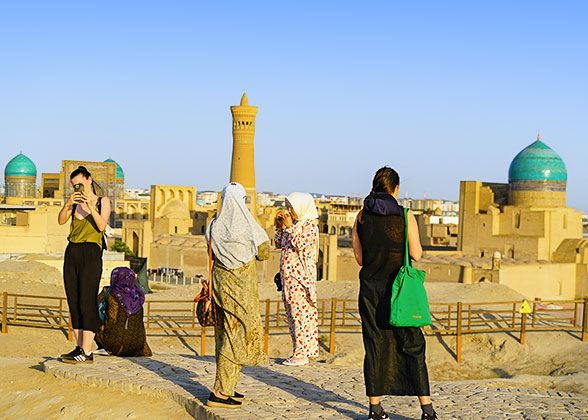
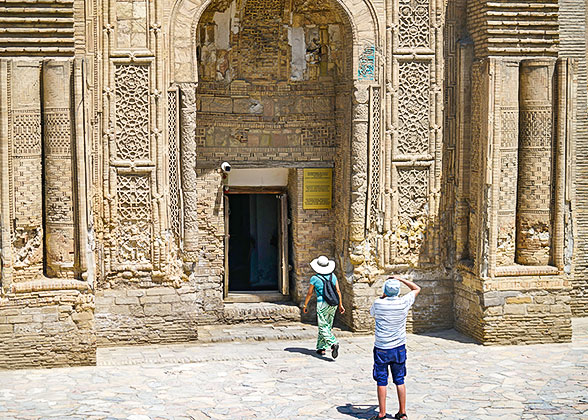
Upon arrival, the local driver will transfer you to the hotel, and then our guide will accompany you to enjoy a Bukhara walking tour. First, head to the 47-meter-high (154-foot) Kalyan Minaret built in the 12th century. Regarded as the lighthouse of the desert, it shimmers under the sun, with intricate geometric brickwork and a honeycomb-like top. After having a peek at the Kalyan Mosque behind the minaret and the adjacent Islamic school, Miri-Arab Madrasah, visit the brick artwork Magoki-Attori Mosque, which was once a shrine of Zoroastrianism in the 5th century, and now houses a museum displaying various exquisite hand-embroidered carpets and prayer cushions.
Then, continue to one of Central Asia’s oldest Islamic institutions, Ulugh Beg Madrasah, and Abdulaziz Khan Madrasah featuring honeycomb-like vaults. Afterward, lose yourself in the four surviving 16th-century bustling Trade Domes Market, whose domes provide an ideal place to escape the summer heat. Vendors’ hawking echoes across vaulted galleries where you’ll find wooden carvings, embroidered suzani textiles, and iconic Uzbek telpak hats.
Following the corridors of the market, let’s get to the Lyabi Hauz Ensemble, the heart of Bukhara. Surrounding its central pond, there are two old Islamic schools, a Sufi shrine, and various restaurants, cafes, and souvenir stores, which is a good place to feel the blend of the past and the contemporary life of Bukhara. Finally, today’s walking tour will end at the Chor-Minor Madrasah. Defying conventional Islamic architecture, this 17-meter-high (56-foot) building resembles a reversed stool. If you ascend its central dome, you can see distinct religious symbolism on the four turquoise domes: Christian crosses, Buddhist prayer wheels, Islamic crescent moons, and Zoroastrian solar disks.
Bukhara honors its Silk Road legacy with this vibrant event biennially in late May or early June. During this time, the old city transforms into a wonderland, where the streets are teeming with stalls of spices and indigo-dyed silks. Besides, the rhythm of traditional drums will resonate with your heartbeat, and the exotic folk dances performed by artists in embroidered robes will feast your eyes. If you are interested in the festival, please let us know so that we can tailor your itinerary according to the time of the festival.
Meals: Breakfast
Accommodation: Volida Hotel Bukhara (3 stars) or similar

Kalyan Minaret, Bukhara

Magoki-Attori Mosque
Day 5 Bukhara: Ark Fortress, Bolo Hauz Mosque, Chashma Ayub Mausoleum, Summer Palace
Our guide will meet you at the hotel in the morning and accompany you to start today’s sightseeing at the Art Fortress. Looming over Bukhara’s northwest, this 5th-century stronghold once shielded emirs’ palaces, mosques, and dungeons within the majestic walls, featuring a white gate. It is said that a Persian gem merchant’s ghost still rattles chains in the prison, where he perished for smuggling turquoises. Climb up its ramparts, and you’ll catch commanding views of the city’s mosaic-like russet roofs and azure domes. Nearby, the Bolo Hauz Mosque beckons you with its 20 carved columns. Stepping into the mosque, you’ll be dazzled by its ceiling adorned with cut-out star-shaped patterns.
Then, wander to the garden to the west of the mosque, where the Samanid Mausoleum is hidden. Different from other Islamic buildings decorated with glazed tiles, the entire building is constructed of bricks, which are assembled into various complex structures, such as circles, rhombuses, squares, rectangles, and arches. Afterwards, visit the Chashma Ayub Mausoleum. According to a Bukhara legend, this sacred site originated during a devastating drought. As locals prayed for water, the prophet Ayub struck the barren land with his staff, bringing a spring with healing functions. In gratitude, locals built the mausoleum over the spring and named it after the saint.
Leaving the mausoleum, we will drive to the suburb to the residence of Bukara’s last ruler, the Summer Palace (Sitorai Mohi Hosa), to admire the buildings that blend Central Asian and European styles. Finally, conclude today’s itinerary at the Memorial Complex of Bahouddin Naqshbandi, a sanctuary of the Sufi sect, composed of the tomb of Naqshbandi, a madrasah, and a museum introducing traditional customs, manuscripts, and the history of Sufism. At the end of the day, you’ll be escorted back to the hotel.
 Dinner Recommendation (at your own expense)
Dinner Recommendation (at your own expense)
The Labi Hovuz Restaurant at the Lyabi Hauz Ensemble is popular among locals and travelers. Nestled by the pool, it offers a stunning night view. Please arrive early if you want to dine at a waterside table. Its lamb skewers and laghman noodles are hot sellers. If lucky, you can listen to a violin performance.
Average Cost per Person: UZS 180,000 (USD 14)
Address: Mehtar Ambar St, Bukhara
Meals: Breakfast
Accommodation: Volida Hotel Bukhara (3 stars) or similar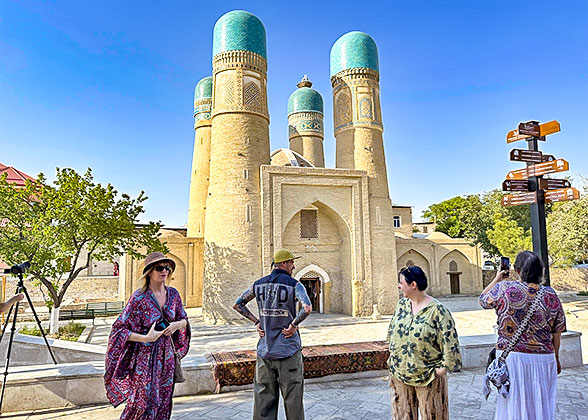
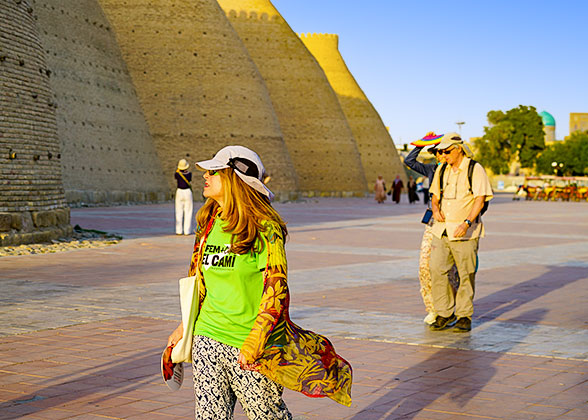
Then, wander to the garden to the west of the mosque, where the Samanid Mausoleum is hidden. Different from other Islamic buildings decorated with glazed tiles, the entire building is constructed of bricks, which are assembled into various complex structures, such as circles, rhombuses, squares, rectangles, and arches. Afterwards, visit the Chashma Ayub Mausoleum. According to a Bukhara legend, this sacred site originated during a devastating drought. As locals prayed for water, the prophet Ayub struck the barren land with his staff, bringing a spring with healing functions. In gratitude, locals built the mausoleum over the spring and named it after the saint.
Leaving the mausoleum, we will drive to the suburb to the residence of Bukara’s last ruler, the Summer Palace (Sitorai Mohi Hosa), to admire the buildings that blend Central Asian and European styles. Finally, conclude today’s itinerary at the Memorial Complex of Bahouddin Naqshbandi, a sanctuary of the Sufi sect, composed of the tomb of Naqshbandi, a madrasah, and a museum introducing traditional customs, manuscripts, and the history of Sufism. At the end of the day, you’ll be escorted back to the hotel.
The Labi Hovuz Restaurant at the Lyabi Hauz Ensemble is popular among locals and travelers. Nestled by the pool, it offers a stunning night view. Please arrive early if you want to dine at a waterside table. Its lamb skewers and laghman noodles are hot sellers. If lucky, you can listen to a violin performance.
Average Cost per Person: UZS 180,000 (USD 14)
Address: Mehtar Ambar St, Bukhara
Meals: Breakfast
Accommodation: Volida Hotel Bukhara (3 stars) or similar

Chor-Minor Madrasah

Ark Fortress
Day 6 Bukhara to Khiva: Drive for 7 Hours through the Kyzylkum Desert
Today, say goodbye to Bukhara, and our driver will escort you to Khiva through the Kyzylkum Desert, taking 7-8 hours. Stretching 298,000 km² across Uzbekistan and Kazakhstan, this rust-hued wilderness earns its Turkic name "Red Sand" from dunes that blaze like embers under sunlight. On the way, you can see wind-carved rocks resembling ancient castles and patches of oasis sheltering gazelles and foxes. Legend claims that in the 13th century, when Mongols swept Central Asia, merchants buried their gold here while fleeing, which attracted various adventurers.
► Tips:
1. Summer (July-August) brings scorching 50°C (122°F) temperatures in the desert, so we recommend you pack some bottled water and sun protective gear to avoid heatstroke.
2. Neck pillows, motion-sickness medication, and dust-proof masks are necessary since the road is bumpy and dusty.
Upon arrival in Khiva, you’ll be directly transferred to the hotel. Founded circa 550 BC as Khwarezm's capital, this desert jewel flourished through Silk Road commerce and evolved alongside Bukhara and Samarkand as the “Golden Triangle” in ancient Central Asia. Have a good rest to refresh from the road trip fatigue and prepare for tomorrow’s Khiva sightseeing.
Meals: Breakfast
Accommodation: Hotel Asia Khiva (3 stars) or similar
► Tips:
1. Summer (July-August) brings scorching 50°C (122°F) temperatures in the desert, so we recommend you pack some bottled water and sun protective gear to avoid heatstroke.
2. Neck pillows, motion-sickness medication, and dust-proof masks are necessary since the road is bumpy and dusty.
Upon arrival in Khiva, you’ll be directly transferred to the hotel. Founded circa 550 BC as Khwarezm's capital, this desert jewel flourished through Silk Road commerce and evolved alongside Bukhara and Samarkand as the “Golden Triangle” in ancient Central Asia. Have a good rest to refresh from the road trip fatigue and prepare for tomorrow’s Khiva sightseeing.
Meals: Breakfast
Accommodation: Hotel Asia Khiva (3 stars) or similar
Day 7 Khiva: Juma Mosque, Tosh-Hovli Palace, Islam Khodja Minaret, Kunya-Ark; Fly to Tashkent
After breakfast, our guide will pick you up at the hotel and head to Ichan Kala, the inner city of Khiva, which is known as a large-scale open-air museum. First, head to the Muhammad Aminkhan Madrasah, which was once one of Khiva’s largest Islamic schools. Now, it functions as a boutique hotel that allows free visits. Before its gates stands the arresting Kalta Minor Minaret, an unfinished 29-meter (95-foot) tower covered in hypnotic turquoise-and-white majolica tiles. In ancient times, people believed that the Persian inscription on the tower could protect caravans through the Kyzylkum Desert. In its neighborhood, the former Islamic hub, Muhammad Rahim Khan Madrasah, now buzzes as a craft bazaar where you can find vibrant suzani embroideries and intricate brass sculptures.
Then, go to the Juma Mosque, concealed behind a millennium-old carved door. Built in the 10th century, this sanctuary lacks the typical Islamic domes and portals; instead, it features 218 columns engraved with exquisite motifs. When the sunbeams pierce through the ceiling, the hall will become even more sacred. Continue to the Tosh-Hovli Palace, a royal residence built between 1832 and 1841, which is regarded as the most beautiful building in Khiva, boasting its carved stone pillars. Entering its restored rooms, you can see the previous furniture, such as beds, chairs, and tables. There is also a small museum displaying royal customs and jewelry accessories. Sometimes, folk song performances will be held in the palace.
Head to the southwest, drop by the Pakhlavan Makhmud Mausoleum with blue domes, and stop at the foot of the 57-meter-high (187-foot) Islam Khodja Minaret. Brave ones can climb its 175-step spiral staircases, where the Ichan Kala unfolds like a LEGO world under your feet. Watch your step while climbing, since the staircases are slippery and narrow.
Our Khiva walking tour will end at the Kunya-Ark, which is very similar to Bukhara’s Ark Fortress. Within the battlements, you can see the palace of the Khan decorated with lapis lazuli ceilings, a coin mint, and prisons preserving chains that were once used to bind offenders. In the fortress’s museum, you can also trace the rise and fall of the Khorezm Empire (1077-1231). Leaving the citadel, you can explore Khiva freely before we transfer you to the airport in Urgench to catch the flight to Tashkent.
 Uzbekistan Street Food Recommendation (at your own expense):
Uzbekistan Street Food Recommendation (at your own expense):
Somsa is a kind of pastry that is conventionally filled with mutton or beef. Baked in a tandir clay oven, it has a flaky golden crust and juicy fillings. If you are a vegetarian, there are also pumpkin, spinach, and potato-stuffed samosas. It can be bought from most restaurants and stalls in the bazaars, costing about UZS 10,000 (USD 0.7) for each.
Meals: Breakfast
Accommodation: Wyndham Tashkent (4 stars) or similar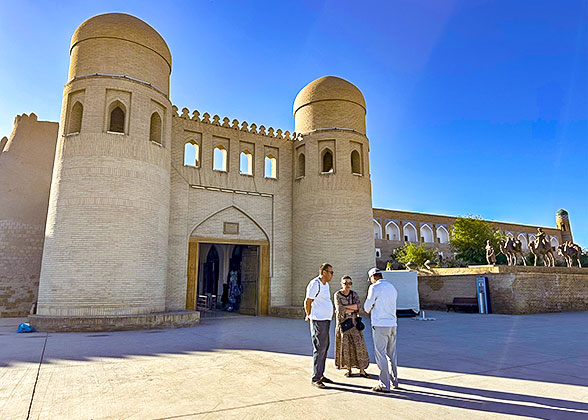
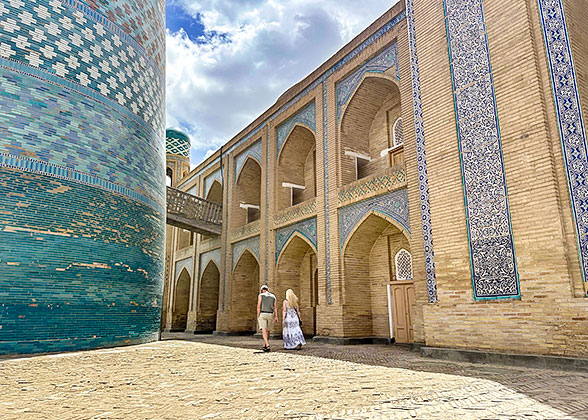
Then, go to the Juma Mosque, concealed behind a millennium-old carved door. Built in the 10th century, this sanctuary lacks the typical Islamic domes and portals; instead, it features 218 columns engraved with exquisite motifs. When the sunbeams pierce through the ceiling, the hall will become even more sacred. Continue to the Tosh-Hovli Palace, a royal residence built between 1832 and 1841, which is regarded as the most beautiful building in Khiva, boasting its carved stone pillars. Entering its restored rooms, you can see the previous furniture, such as beds, chairs, and tables. There is also a small museum displaying royal customs and jewelry accessories. Sometimes, folk song performances will be held in the palace.
Head to the southwest, drop by the Pakhlavan Makhmud Mausoleum with blue domes, and stop at the foot of the 57-meter-high (187-foot) Islam Khodja Minaret. Brave ones can climb its 175-step spiral staircases, where the Ichan Kala unfolds like a LEGO world under your feet. Watch your step while climbing, since the staircases are slippery and narrow.
Our Khiva walking tour will end at the Kunya-Ark, which is very similar to Bukhara’s Ark Fortress. Within the battlements, you can see the palace of the Khan decorated with lapis lazuli ceilings, a coin mint, and prisons preserving chains that were once used to bind offenders. In the fortress’s museum, you can also trace the rise and fall of the Khorezm Empire (1077-1231). Leaving the citadel, you can explore Khiva freely before we transfer you to the airport in Urgench to catch the flight to Tashkent.
Somsa is a kind of pastry that is conventionally filled with mutton or beef. Baked in a tandir clay oven, it has a flaky golden crust and juicy fillings. If you are a vegetarian, there are also pumpkin, spinach, and potato-stuffed samosas. It can be bought from most restaurants and stalls in the bazaars, costing about UZS 10,000 (USD 0.7) for each.
Meals: Breakfast
Accommodation: Wyndham Tashkent (4 stars) or similar

Ichan Kala of Khiva

Kalta Minor of Khiva
Day 8 Departure from Tashkent, Airport See-off
Your 8 days best Uzbekistan tour packages will end today! The driver will see you off at the Tashkent airport. Pleasant flight home!
Beyond Islamic buildings, we can extend your itinerary to Uzbekistan’s renowned natural beauty, such as the Aral Sea and Aidarkul Lake. If you are craving the history of the Silk Road, we can also tailor the trip to Tajikistan, Kazakhstan, Kyrgyzstan, and Turkmenistan. Looking forward to your consultation!
Meals: Breakfast
Beyond Islamic buildings, we can extend your itinerary to Uzbekistan’s renowned natural beauty, such as the Aral Sea and Aidarkul Lake. If you are craving the history of the Silk Road, we can also tailor the trip to Tajikistan, Kazakhstan, Kyrgyzstan, and Turkmenistan. Looking forward to your consultation!
Meals: Breakfast
Expand All
Collapse All
This trip can be customized to meet your individual needs!
Tour Prices
2025 & 2026 Specials: 10% off - Book before July 31, 2025
| Travelers | 2-3 travelers | 4-5 travelers |
|---|---|---|
| Year Round | USD1779 USD1601 | USD1499 USD1349 |
- Prices are per person on twin sharing.
- The prices in red reflect 10% discount.
- If you are a group of 6 people or more, we will offer a more favorable price by your group size.
Price Includes
- Economy class airfare of Urgench - Tashkent
- Train fare of Tashkent - Samarkand - Bukhara
- Accommodation with daily breakfast at selected hotels
- Service of English-speaking local guides for sightseeing
- Service of private air-conditioned car with driver
- Entrance fees for the mentioned sights visited
- Free bottled water daily in the vehicle
Price Excludes
- International flight into and out of Uzbekistan
- Meals other than those mentioned in the itinerary
- Personal expenses (such as laundry, telephone, drinks, etc.)
- Tips for guide and driver
- Personal travel insurance
- Uzbekistan visa fee
Itineraries you may also like:
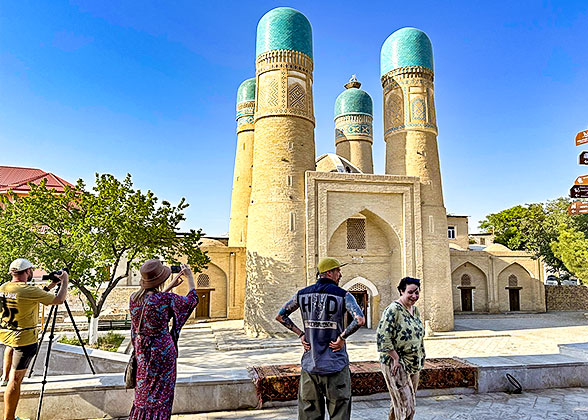 10 Days Tashkent - Urgench - Khiva - Kyzylkum Desert - Bukhara - Nurata - Safari Yurt Camp - Samarkand - Tashkent from USD1574
10 Days Tashkent - Urgench - Khiva - Kyzylkum Desert - Bukhara - Nurata - Safari Yurt Camp - Samarkand - Tashkent from USD1574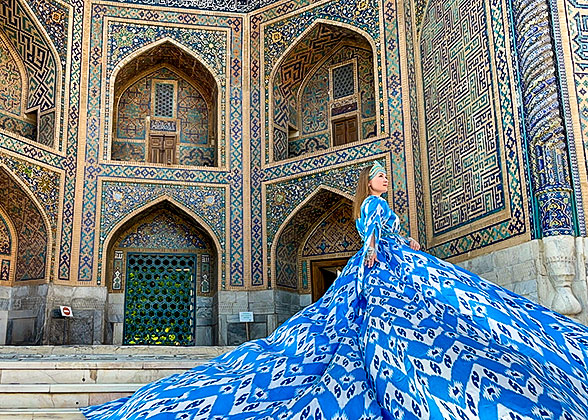 12 Days Tashkent - Nukus - Muynak - Nukus - Khiva - Kyzylkum Desert - Bukhara - Shakhrisabz - Samarkand - Tashkent from USD1844
12 Days Tashkent - Nukus - Muynak - Nukus - Khiva - Kyzylkum Desert - Bukhara - Shakhrisabz - Samarkand - Tashkent from USD1844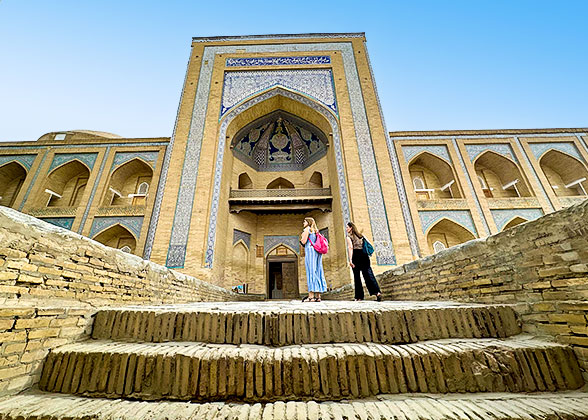 17 Days Tashkent - Nukus - Muynak - Nukus - Kunya Urgench - Darvaza - Khiva - Bukhara - Samarkand - Penjikent - Khujand - Fergana - Osh - Chon Kemin - Bishkek
17 Days Tashkent - Nukus - Muynak - Nukus - Kunya Urgench - Darvaza - Khiva - Bukhara - Samarkand - Penjikent - Khujand - Fergana - Osh - Chon Kemin - Bishkek
